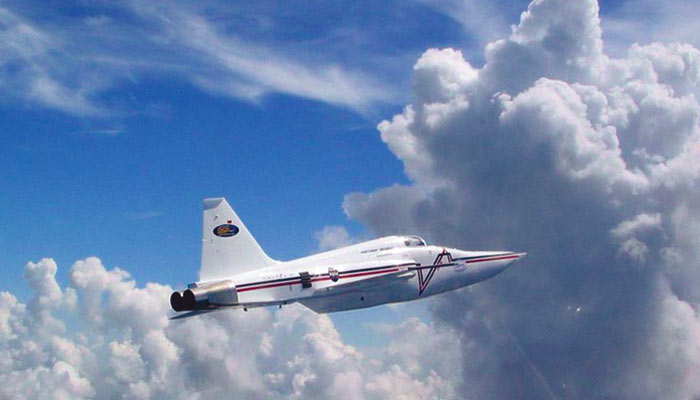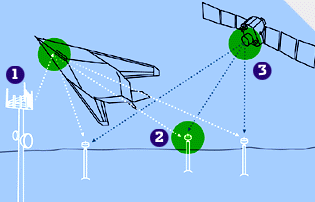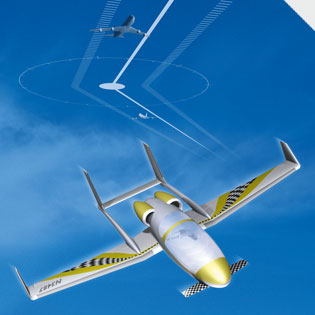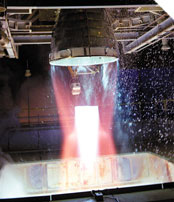

When a Concorde jet on its way from Paris to New York crashed on July 25, 2000, killing all 109 people aboard and four on the ground, the event was not simply a tragedy — it seemed a metaphor for the sorry state of supersonic air travel.
Since its glamorous debut in 1976, the Concorde has remained a symbol of wealth and power but has become a technological dinosaur. It’s still the only commercial airplane that travels faster than the speed of sound, but it burns so much fuel, and its complex 1960s-era technology needs so much maintenance, that fares are absurdly high: $12,750 roundtrip from New York to London. And then there’s its biggest drawback: the Concorde’s sonic boom — a thunderous double explosion that can shatter windows in the buildings below. This has restricted the Concorde to trips over water.
Recently, though, supersonic flight has been making a comeback. Gulfstream, a company best known for making planes that chauffeur celebrities and corporate execs across the skies, has been quietly hiring aviation specialists from NASA and Lockheed Martin. The company is especially interested in experts who understand the strange things that happen when air tries to flow around a supersonic airplane and who have experience with triangle-shaped delta wings and heat-resistant materials. People, in short, who may know how to silence the sonic boom. Gulfstream’s goal: to make a passenger jet for the rich that can smash the sound barrier yet is quiet enough to fly anywhere, anytime. Imagine leaving New York at 7 a.m., flying to Moscow for a 2-hour meeting, and returning home in time for dinner. Or picture doing L.A. to New York in 2 hours, instead of the 51/2 it takes now.
Gulfstream’s efforts coincide with the U.S. military’s newfound interest in developing a next-generation supersonic plane. Since the end of the cold war, military engagements increasingly have been occurring in areas far from U.S. and Allied airfields, so getting there fast has become a more urgent issue. During the Gulf War, B-52 bombers took off from a U.S. military base on the island of Diego Garcia in the Indian Ocean; it took them 7 hours to reach Iraq. Cutting flying time in half would have great strategic value. With that in mind, the U.S. Defense Advanced Research Projects Agency awarded close to $35 million in contracts last year to the big three U.S. aviation companies — Boeing, Lockheed Martin, and Northrop Grumman — for supersonic research. If DARPA gets more money from Congress, it will select one of the three to build a prototype low-boom supersonic plane — a so-called X-plane — to showcase the latest technologies.
The current interest in supersonic flight is something of a surprise, given how many previous efforts have failed. The United States, Russia, France, and Britain have been building supersonic airplanes since the 1950s, but so far nobody has produced one that makes sound commercial sense. Most recently, in 1999 NASA and Boeing abandoned a 10-year, $1 billion joint effort to build a 300-seat commercially viable supersonic airliner. Despite technical successes, Boeing ultimately deemed the project financially impractical and pulled out. Given how difficult it is to launch a relatively straightforward project like the Airbus A380 double-decker jumbo, Boeing bosses balked at selling airlines on something as risky and radical as a supersonic jet.
Nevertheless, supersonic researchers today radiate a newfound optimism: Barnaby Wainfan, an aerodynamicist at Northrop Grumman, says the goal “is to explore the possible and the only slightly impossible.”
Lowering the Boom
With all the starts and stops of the past, why has Gulfstream decided to start chasing the supersonic dream? Because it’s decided the money’s there. Gulfstream’s customers, the wealthiest people in the world, are already willing to drop $45 million on a conventional private jet like the Gulfstream V. The G-Five is the company’s intercontinental business jet. Built to land on relatively short (6,000-foot) runways, it justifies its price by flying between small, uncrowded airports close to the traveler’s final destination. But it flies at the same poky rate as a Boeing 747.
Since time is money, Gulfstream presumes the same people who buy G-Fives would happily pay $80 million to go twice as fast. Richard Santulli, chairman and CEO of Executive Jet, the largest business jet operator in the world, told Wired and The New York Times last year that his company would buy a large fleet of low-boom supersonic business jets as soon as they became available.
But Gulfstream still needs to overcome a major hurdle: the boom. Until recently, most people thought the boom was an inescapable consequence of supersonic flight. Why? A regular, subsonic jet — say, a 747 — travels at about 550 miles per hour. That’s slower than the speed of sound, which is 760 mph at sea level, and more like 660 mph at the altitudes where jets cruise (sound travels more slowly in thinner air). The air a jet displaces normally flows around the plane the same way a stream flows around a rock. But when an airplane surpasses the speed of sound, the air can no longer easily flow out of the way. Instead, the plane compresses the air as it passes through. The impact then sends a pressure pulse through the atmosphere.
The intensity of the pressure pulse decreases as it moves away from the airplane. But at the same time, the pulse changes shape, coalescing into an N-shaped wave. Within the N-wave, the pressure rises sharply, declines gradually, and then snaps back up to the normal atmospheric pressure. Meanwhile, a wall of compressed air, moving at the speed of the airplane, spreads out from the wave. As the wall of air passes over the ground, it is heard and felt as a sonic boom. The human ear picks up the pressure increases at the front and back of the N-wave, which is why the boom is often heard as a double bang.
The big news in low-boom research is that it appears possible to reduce the boom intensity simply by changing the shape of the airplane. For one, small planes create less of a disturbance. That’s because the sonic-boom problem is caused by air displacement: Planes rest on a column of compressed air, and the lighter the plane, the lower the pressure.
Shape is just as important as size. If the plane is long in proportion to its weight, the N-wave is spread across a greater distance and the peak pressure will be lower. In addition, if the wings are spread along the body, not concentrated in the center as in a conventional plane, the pressure pulse bulges less and there’s a smaller boom. The Gulfstream plane would be about 140 feet long but carry only 8 to 14 passengers.
Pres Henne, Gulfstream’s senior vice president for programs, folds his arms to demonstrate these concepts. “There’s a sweet spot here,” he says, indicating the place where his arms cross. If the airplane is relatively skinny and flies at just the right altitude, there is a point where the N-wave does not form and the peak energy at ground level — the boom — is weak.
The question remains: How quiet is quiet enough? Nobody really knows for sure. Researchers have decided, however, that it’s really not crucial to find out. Rather than trying to decide where the acceptable sound threshold lies, they’ve decided to skip a step, simply setting a radically low goal for boom noise. Whereas the pressure at the front of the Concorde’s N-shaped boom jumps by 2.1 pounds per square foot, the new designs aim for a boom with a maximum pressure rise of just 0.3 pounds per square foot. That’s only one-seven-thousandth of the air pressure at sea level — you feel a bigger change riding three floors in an elevator.
A Faster Jet for the Jet Set
The quiet supersonic airplane Gulfstream plans to build will cruise between Mach 1.6 (1.6 times the speed of sound, or slightly less than 1,100 mph) and Mach 2 (1,320 mph), and will be able to cover at least 4,600 miles before having to stop for refueling. Gulfstream plans to start manufacturing the plane — its so-called quiet supersonic jet, or QSJ — by 2006.
Beyond conquering the boom, one of the biggest obstacles is building a reasonably priced engine that won’t inflict front-row-Metallica-decibel noise on airport neighbors (we’re talking about regular noise here, not sonic booms). The engines on today’s jetliners are quiet thanks to big thrust-producing fans in the front, but they won’t work on a supersonic plane because at ultrahigh speeds the airflow through the fans is not fast enough to produce any thrust.
What’s the solution? The simplest sort of supersonic engine is one that inhales the least possible amount of air and blows it out the tailpipe as quickly as possible, but unfortunately that design doesn’t solve the loudness problem. The supersonic plane that NASA gave up on three years ago had a jet engine of this type, and it needed a noise suppressor that was the size of a motor home.
General Electric has designed a variable-cycle engine whose internal valves and moving blades enable it to operate in three modes. On takeoff and landing — the times when noise is most bothersome — it’s a quiet engine that works much like today’s jet engines; during acceleration through Mach 1, it works like a simple but noisy supersonic engine; and for cruising it adopts a setting between the two.
Rolls Royce, meanwhile, has proposed a compromise engine design that meets takeoff noise requirements, just barely, and without any extra moving parts. The company plans to take its Trent 800 engine, a 95,000-pounds-of-thrust giant made for the Boeing 777 airliner, remove the fan that produces most of the thrust, and replace it with a smaller, higher-pressure fan.
Engine development won’t be cheap. Both Rolls Royce and General Electric, however, are proposing to make supersonic engines in which the hot, high-pressure core — the most expensive part — is identical to the core on bigger, conventional commercial engines, a move that would spread the investment over a bigger market.
Environmental complaints have dogged the Concorde, which spews vast amounts of nitrogen oxides at high altitudes, causing damage to the ozone layer — the natural atmospheric filter that protects life on Earth from the sun’s ultraviolet rays. Those harmful effects were one reason that the U.S. scrapped its original supersonic jet program in 1971. But those concerns are receding. Researchers involved with the NASA supersonic project designed combustors — the section of the engine where the fuel is burned — that produce fewer nitrogen oxides. Some of that technology is already being used on subsonic engines with substantial success.
But even if the technological hurdles are overcome, political ones remain. Gulfstream officials say they aren’t going to invest seriously in a supersonic program until DARPA starts building a demonstrator plane and the Federal Aviation Administration shows that it will respond by revising its no-supersonic-overland rules. A low-boom plane is valueless without permission to fly.
The Design Strategy
Gulfstream’s quiet supersonic jet design shares some features with the company’s existing planes — such as a T-tail and engines high on the rear fuselage — but it is more slender. It has a long nose to stretch out the pressure wave, and big, sharply swept arrow-shaped wings. The wings mask the shock waves from the engine air inlets and keep them from reaching the ground. Gulfstream’s quiet supersonic jet won’t be fuel-efficient, but Henne doesn’t see that as a problem. “Machines in this market are not designed for minimum operating cost per seat,” he says, with some understatement. Translation: If you can afford a Gulfstream, you’re not worried about a few lousy tons of fuel.
The three designs proposed for DARPA range from a little to a lot more exotic in appearance than the Gulfstream jet, and for good reason. DARPA’s goals are quite a bit loftier. The agency wants to build an airplane that can carry 20,000 pounds worth of bombs or other payload for 7,000 miles without refueling — a task that would be respectable for a subsonic airplane — at speeds of at least 1,600 mph. “It’s very tough,” says Northrop Grumman program manager Charles Boccadoro. “You set the target a little beyond what you can do.” But, he adds, “we’ve identified technologies that get very close to DARPA’s goals.”
The military doesn’t have to worry about reduced sonic boom as much as business-jet manufacturers do. U.S. Air Force and Navy pilots can train at supersonic flight over water or in desert areas of the Southwest where they have exemptions to fly overland. Moreover, the noise isn’t a strategic drawback — by the time the enemy hears the boom, trailing behind the airplane, it’s too late. But Boccadoro points out that supersonic planes of the future would fly at top speeds for long distances, so it would be useful if they could train outside the military test ranges. Not only that, but DARPA’s mandate is to develop technologies that have potential for civilian as well as military uses — hence its involvement in developing quiet supersonic flight.
Computational fluid dynamics, or CFD, has emerged as an essential tool in boom research. Like an electronic wind tunnel, CFD uses computer hardware and software to model the way air flows around an airplane. The method keeps getting more powerful. In the 1990s, says Boccadoro, “we could use CFD to model sonic pressures on the body itself,” but that told the engineers little about how the boom would develop. Today, says Boccadoro, “with the explosion of power and memory, we can compute flows out to four body lengths in high fidelity.”
If the designers manage to do this, they can accurately predict the way the boom will resonate hundreds of body lengths away from the airplane, where it ultimately hits the ground.
Late this summer, Northrop Grumman will test the company’s CFD-based design concepts with a modified F-5E Tiger fighter plane that has a longer nose and recontoured body. The F-5E will fly over an array of microphones at speeds up to 1,000 mph. What the engineers want to find out is whether the far-field effects — the measured boom on the ground — match the predictions. If they do, then Boccadoro’s team and others will be well on their way to designing the low-boom supersonic jet of the future.
Concorde Discord
A technical triumph when it debuted in 1976, the Concorde is still the only commercial supersonic airliner. Due to its deafening sonic boom, however, it’s banned from overland flight, and mostly earns its keep bouncing back and forth from New York to Paris and London — a trip it makes in 4 hours.
The plane flies at twice the speed of sound, around 1,350 miles per hour. It seats 100, and is so inefficient and costly to operate that a round-trip ticket costs about $12,000 — the price of a new Honda Civic. (The leather seats and free champagne do something, perhaps, to cushion the blow.) The Concorde fleet returned to service late last year after being grounded for 16 months after a crash.
The British and French governments agreed to build the airplane in 1962, under a treaty that would not let either side back out, however much the cost went up. Most airlines canceled their orders by 1973. Notably, Lufthansa’s technical director, Reinhardt Abraham, remarked that he would not operate a Concorde if St. Nicholas left one under his tree. That was virtually what happened to the 16 production airplanes that were built; the last five were sold to British Airways and Air France for one French franc apiece.

























